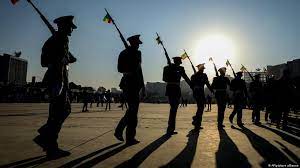Mass Ethnic Killings in Ethiopia
- Hiba Siddiqui

- Nov 24, 2021
- 3 min read
Fast approaching warning signs show possibilities of acts of genocide being committed in Ethiopia.

Source: Gariwo. A decades long conflict turns into a civil war plunging Tigray into famine and mass starvation.
Background: How did the conflict start?
Between November and December 2020, a civil war took place in Tigray, a region a part of Northern Ethiopia. The war involved the Ethiopian army commanded by Prime Minister Abiy Ahmed, who was a recent recipient of the Nobel Peace Prize for settling regional disputes between Eritrea and Ethiopia, and the Tigray’s People Libration Front (TPLF) which challenged Ethiopia’s central government. The war was officially ended in December, yet the conflict kept escalating and ravaging the Tigray region.
The Tigray conflict has its roots in tensions that go back generations in Ethiopia. Ethiopia is the second most populous African country and is made up of 10 regions that are self-sufficient. Before Abiy Ahmed become the Prime Minister, the TPLF had even the governing strict power in Ethiopia, overseeing a period of stability and economic growth at the cost of freedoms. Ahmed was appointed to the ruling position to turn the tide and establish democratic change in Ethiopia after the TPLF’s authoritarian rule. Ahmed made plans for reorganizing the coalition which sparked fear in the Tigray region.
Tensions boiled over in September 2020, when Tigrayans defied Ahmed directly by going ahead with regional parliamentary elections that he had delayed. Ahmed called the vote illegal and cut funding for the TPLF. On November 4, 2020, after accusing the TPLF of attacking a federal army and attempting to steal artillery, Abiy ordered a military assault against the group, sending in national troops and fighters from the neighboring region of Amhara, along with soldiers from Eritrea.
Now, more than two million people are internally displaced with four million requiring aid due to the fighting. The Ethiopian army has been being backed by Eritrean troops and both are being accused of ethnic cleansing in Tigray.
Violence in Tigray: What violations were committed in Tigray?
For months at the start of the conflict, Ahmed denied that there were civilian casualties. But, reports from outside sources proved that account irrevocably wrong.
Thousands of people have died in the fighting with reports of inhumane refugee camps, looting, sexual violence, rape, massacres, and killings. Many people have fled to neighboring countries in seek of asylum.
Ethiopia’s government has severely restricted access to media outlets, and have order a state enforced communications blackout to conceal the events in the region. However, repots for Amnesty International and exclusive reports give a key account of the atrocities
occurring in Ethiopia.
The Eritrean forces have been linked to some of the most gruesome attacks, in addition to perpetuating mass killings and rape, Eritrean soldiers have also been found blocking and looting food relief in multiple parts of Tigray.
In September, the UN said that a “de facto humanitarian aid blockade” was limiting its ability to access more than 5 million people in Tigray in need of humanitarian with over 400,000 people facing famine conditions.
There have been claims of starvation and rape as a method of warfare in the region with multiple claims of crimes against humanity. Civilians in Tigray have been subjected brutal violence and the seriousness of the abuses demands all perpetrators be held accountable on all sides.
Current Conditions in Tigray: What’s happening now?
The Ethiopian government declared a ceasefire in June , but the TPLF rules out a truce, and the fighting has spread beyond the borders of Tigray and into Amhara and Afar regions. The rapid advance of fights has raised fears among leaders that the Ethiopian capital could fall.
Ethiopia has announced a state of emergency as the conflict escalated. Tigrayan forces claim to have captured near Addis Ababa, the capital of Ethiopia. As fights continue to strife towards the capital, Ethiopian government’s airstrikes on regions of Tigraya have intensified.
As the war continues and civilian casualties increase, international leaders have voices concern over the violence occurring in Ethiopia. Efforts are being made to find outlets to help the Tigrayan people, but it is unclear if there will much of a difference in the country.
The only way to help the people suffering in Ethiopia right now is through global awareness and sending support to humanitarian nonprofit organizations. The people of Ethiopia are in dire need of aid and the only way to provide relief is by donating to agencies dedicated in alleviating the suffering of the Tigrayans.










Comments